skip to main |
skip to sidebar
To anyone who knows Hindi, I guess the name of this dish would sound somewhat strange, because "dal-chawal" means literally "pulses-rice". In a more figurative sense "dal-chawal" is also used to describe basic everyday necessary food - like the term "daily bread".
I think I'm not getting this across very well, so I'm going to stop trying. Besides, if I havent made myself understood yet, more babble is hardly likely to encourage comprehension.
I call it dal-chawal pulao, however, because I couldnt come up with a better name for it. Besides, the main ingredients are as basic as that - dal (brown lentils in this case) and Basmati chawal. Add to it a cupful of sliced shallots and some spices - and you get a pulao that's extraordinarily tasty. I couldnt believe it myself, really. The aroma and the taste were addictive.
In fact, although Pete had alu-matar with it, I ended up eating just the pulao, spoonful by spoonful. I loved the taste and texture of the brown lentils - they cooked quite quickly but retained their shape beautifully even though technically I overcooked it. Any other dal would have turned to mush, but not my lovely brown lentils.

Um, actually they could be green lentils. I'm not sure what they're called... but you can see from the photo that they're a greyish colour when dry, turn somewhat green when soaked for a couple of hours, and cook to a dark shiny brown. Chameleon lentils, perhaps? :)
Recipe for: Dal-chawal pulao

Ingredients:
1/2 cup green or brown lentils, soaked for 2-3 hours
1 cup good-quality basmati rice, soaked for 15 minutes
1/2 cup shallots, sliced thin
2 bay leaves
1 black cardamom pod, slightly crushed
1" piece cinnamon stick
3-4 fresh green chillies, split lengthwise
1 tsp grated ginger
1 tsp coriander powder
1 tbsp oil (or ghee, for a richer flavour)
Salt to taste
2 cups water
Method:
1. Two-three hours before you make the pulao, soak the lentils in water.
2. Wash the basmati rice 3-4 times, then let it soak for about 15 minutes, while the shallots and dal are spiced.
3. In a wide, heavy-bottomed pan with a lid, heat 1 tbsp oil. Add the cardamom pod, cinnamon stick, bay leaves and slit green chillies and fry for about a minute on high heat, stirring often.
3. Now add the shallots and grated ginger and stir fry on medium heat till the shallots are soft and turning pale brown. Stir in the coriander powder.

4. Drain the brown lentils and add to the shallots, mixing well.

Pour in 1/4 cup water, turn down the heat to medium-low, and cover the pan. Cook the lentils for about 10 minutes.
5. Turn up the heat to high and add the soaked, drained Basmati rice. Stir it all about for a couple of minutes. Add salt to taste and stir again.

6. Pour in 1-3/4 cups water and bring to a rolling boil.

Then turn down the heat to low, cover the pan again and cook for 15 minutes undisturbed.
7. Check the rice now to see if the water has been absorbed. If it has all been absorbed but the rice looks underdone, sprinkle 3-4 tbsp water, cover the pan again and cook for another 5-7 minutes.
8. Turn off the heat and let the pulao sit covered for 10 minutes before fluffing it with a fork. (Remove the whole spices and the bay leaves now, unless you like biting into them!) Serve hot with any curry.
The word "muLlu" translates into "thorn" in Tamil - and it's an apt description for this savoury crunchy snack, because it DOES have little "thorns". That's because the plate with the star-shaped hole is used in the "murukku press".
I made this for post-Christmas holiday snacking since I was not enamoured of all the strangely potato flavoured crisps that appeared during that time. If you went by just the names alone, you'd think that nobody needed to cook a turkey or goose or anything else for Christmas. Why bother when you could get an entire Christmas feast of potato crisps, like "turkey with cranberry sauce", "roast lamb and mint sauce", "honey baked ham with onions". Right?
Wrongo.
We didnt buy a single pack of those ambitiously stupid Christmas crisps. We made do with some home-made snacks and salted nuts.
Actually I almost didnt make these mullu thenkuzhal when I discovered that the recipe called for moong dal flour. I didnt have any such thing. But then I decided to make the extra effort (Christmas, after all) and ground moong dal to as fine a powder as possible in my little coffee grinder. It took a lot sifting and grinding, and even more patience, but I persevered. And finally I had the 1/2 cup of very fine moong dal flour required for the recipe.
Next time I make this it will be a LOT simpler, because I'm asking my mother to bring some moong dal and urad dal flour from India when she comes in end-Feb. Cant wait for these and other goodies to arrive with her but I'll be patient till then. Or burst trying.
Recipe for: MuLlu thenkuzhal
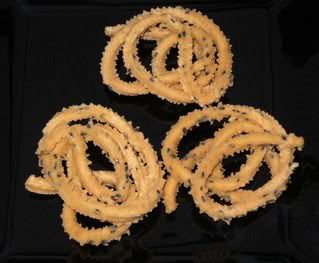
Ingredients:
Rice flour - 2-1/2 cups
Gram flour (besan) - 1/2 cup
Moong dal flour - 1/2 cup
Urad dal flour - 1/8 cup
Salt to taste
1/4 tsp asafoetida powder
2 tsp red chilli powder (or to taste)
2 tbsp sesame seeds (I used black for contrast)
1 tbsp butter
Water as required
Oil for deep frying
Method:
1. Mix all the ingredients in a large bowl.
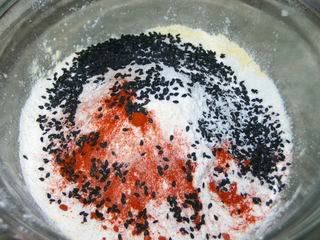
Make a fairly stiff dough, using only as much water as required - the dough should be pliable but not anywhere near runny. Keep covered with a damp cloth.
2. Heat the oil on high. When a small piece of dough dropped in rises to the top immediately, the oil is at the right temperature.
3. Pinch off a portion of dough to fit into the press (use wet fingers to push the dough in, if it's turned out too stiff) and quickly make squiggly round shapes - 3 or 4 at a time, or one large one, as you like.
4. After a minute or so, turn the heat down to medium high and fry the thenkuzhal, turning occasionally, till it is golden brown and crisp. Drain on absorbent paper and store in airtight tins. This keeps fresh for 3-4 weeks - assuming it doesnt get polished off in the first two days!
This chutney was inspired by a recipe that I saw on Sailu's Food - a blog which I love for the quality of photos and the recipes. I'd say the ingredients are pretty much those listed on Sailu's recipe for coriander-coconut chutney, but I played around with the quantities a little. I prefer my chutneys not to be overwhelmed by the peanut taste and texture, otherwise it ends up like rather strange peanut butter to me. Good for sandwiches but not really dosas or idlis or rice, as I discovered. But of course, goes without saying (even though I'm saying it) that's just the opinion of MY peculiar taste-buds.
Recipe for: Coriander-mint-peanut coconut chutney
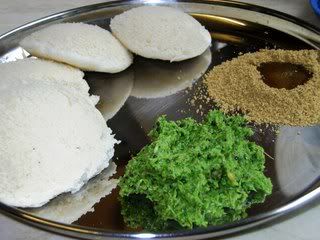
Ingredients:
1 tsp oil
1/2 cup fresh grated coconut
1 tsp cumin seeds
1/2 cup fresh coriander leaves, chopped
10 mint leaves
5 green chillies, chopped roughly (or as per taste)
1 tbsp roasted peanuts (I used the ready-bought roasted salted kind)
Water as required
Salt to taste
For tempering:
1 tsp oil
1 tsp mustard seeds
1 tsp urad dal
4-5 fresh curry leaves, torn
pinch asafoetida
Method:
1. Heat 1 tsp oil in a small pan and roast the cumin seeds. green chillies and coriander and mint leaves till the leaves are wilted.
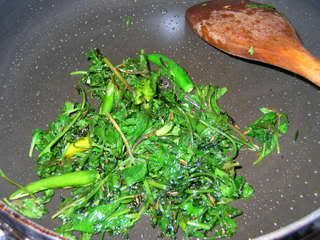
2. Let cool then grind the wilted leaves with the coconut and peanuts until smooth, using water as required. If you like the chutney thick, use only as much water as required to grind without trouble. To make a runnier chutney (for rice, for instance), add a little more water till you get the consistency required.

3. Add salt to taste and mix.
4. Heat the remaining tsp oil, add the asafoetida powder, mustard seeds, curry leaves and urad dal. Cover and let the seeds splutter, then immediately pour the tempering over the chutney. Mix well. Serve with dosa, idli, vada, etc.
Pete tasted the Venn Pongal I made yesterday, a little doubtfully.
No green chillies lurking in it? he asked.
No, honestly. Just black pepper.
Hmmmm, he said, after a mouthful. There's something missing, it's a bit bland.
Bland? With the lashings of black pepper in it?
Yep, bland, he insisted.
Perhaps it was lacking in salt?
Nope, it tasted fine for salt, he said. Just bland.
I got the idea. My nice hot pongal was, apparently, bland. So I went away and had another go at sampling it, tasting the combined flavours of the moong dal and pepper and ghee and cashews and curry leaves and cumin seeds on my tongue, wondering exactly which of these ingredients was the offender.
I was tasting my 7th or 8th spoonful of pongal - with no clear decision on the elusive bland item (but I wasnt complaining as the tasting was going quite well) - when the Lord of the Manor sauntered into the kitchen.
I have it, he said. I know how to remedy the blandness.
Really? Wanna tell me how?
Sure, he said. Let's see... got any fresh carrots?
Carrots? Sure. One fresh carrot coming up.
Right, he said. Got any lemons?
Got those too. What next? What's your plan?
Well, he said. The plan is to grate the carrot, relieve the lemon of its juice and combine the two with the pongal.
WHAAAAAT? You heard me, he said, as he grated the carrot and relieved the lemon of its juice with an extra flashy squeeze, a la Ainsley Harriot. Let me have some of that pongal... what do you mean, over your dead body? Blimey, anyone would think I'm going to do vile unmentionable things with it. JUST GIVE IT HERE, will you?!
Ohhh, my pongal, my nice pongal!
Ok, it's ready, he said. Now try it.
And because it seemed like I would be force-fed if I didnt try it, I did.
So, he said. What do you think?
Hmmm... actually, it's surprisingly yummy.
Excellent, he said. I knew the lemon juice would give that much-needed zing and cut through the heat of the black peppercorns, and fresh carrot would give it some crunch.
mmm...youwererightmmmm...
I'd like some too, you know, he said. ...WHAT DO YOU MEAN, OVER YOUR DEAD BODY???!!!!
Recipe for: Venn Pongal - variation
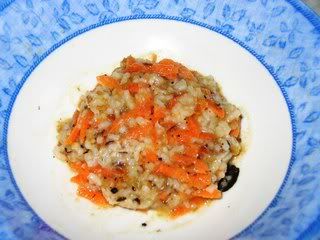
Ingredients:
1 cup Venn pongal
1 medium carrot, grated
Juice of one large lemon, or as required
Method:
Mix the lemon juice and carrots with the hot pongal. Taste for blandness (or lack thereof), adding more lemon juice if required. Serve at once.
First of all, happy Pongal/Makar Sankranti to everybody!
"Pongal" denotes the name of the harvest festival as well as the sweet rice pudding that is made traditionally on the day, In Tamil, it means "boiling over". Usually sweet or "chakkara" pongal is made, but I went with both varieties because a friend of mine wanted to know how to make the savoury kind, or Venn pongal, as it is known. All I can say is, I hope she likes my version!
I like black peppercorns but only when powdered - to bite into one is one of my least favourite things to do (the others being biting into pieces of ginger, or whole cardamom - bleagh!). Anyway, so when I make Venn pongal, I crush the peppercorns to a coarse powder.
To anybody who might conceivably want to try my recipe for Venn pongal, please be aware that the traditional way to make it is to leave the peppercorns whole.
The quantities used in the recipes below make enough for one person. A tip: If the Venn pongal turns out too thick, add some water just off the boil and stir briskly to bring the pongal to a more "runny" consistency.
Update: I forgot to mention that for chakkara pongal, you can use 1/2 cup milk + 1/2 cup water, or even just milk to cook the rice+dal. Makes the chakkara pongal tastier, basically.
Recipe for: "Chakkara" pongal and Venn pongal
Chakkara pongal
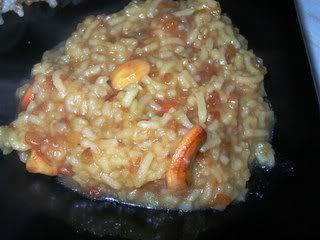
Ingredients:
1 tbsp moong dal
3 tbsp rice
1 cup water (or 1/2cup milk + 1/2cup water, or even 1 cup milk)
1/2 tbsp ghee
1/4 cup jaggery/gur/palm sugar
2-3 strands saffron (optional)
1/4 tsp powdered cardamom seeds
1 tbsp cashew nuts
1 tbsp raisins
Method:
1. Dry-roast the moong dal, stirring frequently, till it becomes golden brown.
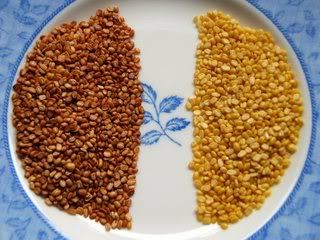
Left: Moong dal roasted. Right: Moong dal raw
2. Add the rice to the dal and wash 3 times in running water.
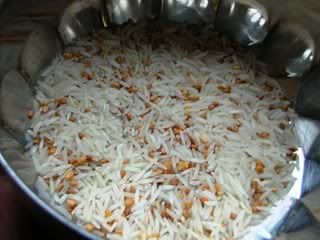
Drain, then add one cup of milk/water to the rice-dal mix and cook in a pressure-cooker for 3 whistles. Turn off the heat and wait till the cooker can be opened. The rice-dal, when cooked, should be well-done and not stand out as separate grains. Mash the cooked rice a bit to break the grains and get the right consistency.

3. Place the jaggery in a pan and add 1/4 cup water.

Bring to a boil, stirring, then add the saffron strands if using. Simmer gently until the jaggery is melted.

Strain the liquid if there is any sediment at the bottom.
4. In another pan, heat the ghee and fry the cashew nuts and raisins till the cashews turn a pale gold.
5. Now pour in the melted jaggery, then add the mashed rice-dal mixture and cardamom powder. Mix well. Serve hot or at room temperature.
Venn pongal
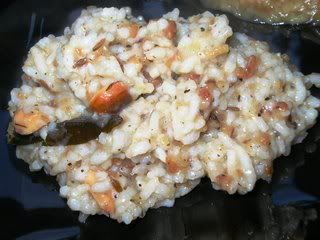
Ingredients:
1 tbsp moong dal
3 tbsp rice
1 cup water
1 htsp black peppercorns (i crushed them but leave them whole if preferred)
1 htsp cumin seeds
1/2 tsp ginger grated
A few curry leaves,torn
1 tbsp ghee
1 tbsp cashew nuts
Salt to taste
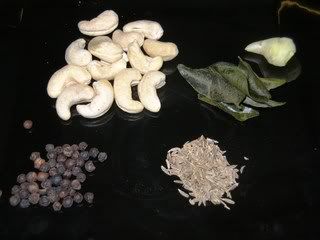
Method:
1. Follow steps 1 and 2 as above.
3. Heat the ghee in a saucepan and fry the cashewnuts till they start turning pale gold. Now add the grated ginger, cumin seeds, curry leaves and peppercorns and fry for 30 seconds, stirring.
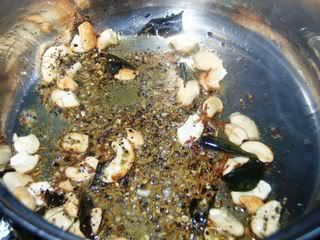
4. Add the mashed rice-dal mix and salt to taste, stirring to mix thoroughly.
5. Heat through, stirring well, and serve hot with coconut chutney or gothsu.
I cant believe it's already nearly two weeks into the new year - how time flies! I've been browing all my favourite food blogs and discovering more and more new ones... most of them with the most delightful, perfect photographs. Blogging about food has certainly awakened the latent photographer in many, many people, methinks. It's all good!
I dont have any new food blog resolutions - no statements of intent whatsoever, because I've found from experience that making any such statements is the most foolproof way of ensuring that I NEVER do what I intended to. So, no resolutions. I resolve never to make any resolutions. That should be an easy one to keep! :)
Babble aside, my first post of 2007 is going to be ricotta rasmalai.

I've been meaning to make this for the longest time, and I managed it just before Christmas, as my contribution to the festivities. I did make a proper Christmas cake too, of course... in fact, that was done in mid-November sometime and kept getting fed weekly with cherry brandy until Christmas Day. That was one BOOZY cake!
But Christmas cake is not what I am going to post about. It's ricotta rasmalai. Quite contrary to expectations, it turned out surprisingly well. Unfortunately Pete is not a fan of milk-based sweets or anything even vaguely eggy or custard-y. Yes folks, the man doesnt like caramel custard - even just hearing the words turns him green. Well, all the more for me, if and when I make caramel custard again.
Hm, caramel custard is not what I was going to post about, either. (Good thing that I didnt make any new year resolutions about waffling less and writing more to-the-point - I would have broken that resolution with my very first post!)
So, the rasmalai.
I had about 350gm (generous cup and a half, I guess, very roughly in volume) of ricotta cheese to which I added a pinch of finely powdered cardamom seeds and 1/2 cup of powdered sugar. I baked this in the oven for about an hour till it was done and "set". For the "ras" (or the milky sauce), I used about 3 cups of whole milk and a can of evaporated (because we dont get half-and-half here).
I'm afraid I cant be any more precise about quantities because I WASNT precise when I poured in the milk. This, simmered until thick, was the "sauce" for the baked ricotta. Of course I added some more cardamom powder to the milk for that heavenly fragrance and flavour. I suppose one reason I was surprised that it turned out so well is that I was so completely vague about the quantities required. All I had in mind was that the ricotta needed to be drained, beaten smooth and baked. After that it was all "andaza" (approximation).
The only trouble was that since there was only me to eat the rasmalai, I had it over an entire week until I was tired of the very sight of the little ricotta squares! Mind, it was excellent rasmalai of the untraditional kind, but I think I might just have cured myself of any craving for it for a verrrrrrry long time! It's true, you CAN have too much of a good thing.
Recipe for: Ricotta rasmalai

Ingredients:
2 small tubs ricotta cheese (200gm each)
3/4 litre whole milk
1 can unsweetened non-fat evaporated milk
1 cup sugar (or to taste)
1/2 cup powdered sugar
1/2 tsp cardamom powder
1/4 cup pistachio nuts, slivered, for garnish
Method:
1. Drain any water out of the ricotta cheese, transfer to a mixing bowl.
2. Add a pinch of cardamom powder and 1/2 cup powdered sugar and beat until really smooth.
3. Transfer to a baking dish and bake it at 180C for about an hour (or until a toothpick inserted in the middle comes out clean). The cheese will have drawn away from the edges of the dish and acquired golden brown patches here and there.

4. Turn out the baked ricotta on a plate. (Mine fell out upside down, so I left it that way!)

5. Cut it into little squares (or whatever shape you like).

6. While the ricotta is baking, put the whole milk, evaporated milk and sugar to taste in a heavy-based saucepan.

7. Bring it to a boil, then reduce the heat to medium-high and let it cook, stirring frequently, until it is reduced in volume by at least half. If you want the sauce to be thicker, continue till it reaches the consistency you wish.
8. Let the milk syrup/sauce cool for about 5 minutes, then add the ricotta pieces to it. Once it is cool, place the rasmalai in the refrigerator for a few hours.
9. Serve chilled, garnished generously with pistachio slivers.




























